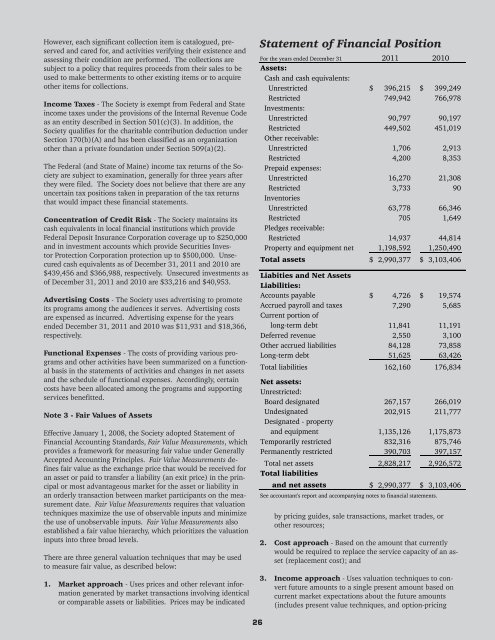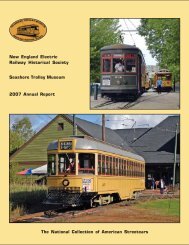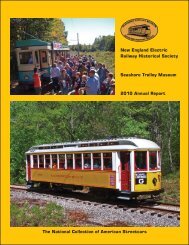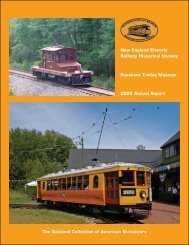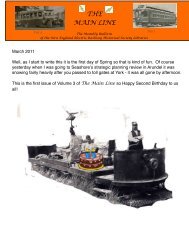2011 Annual Report - the Seashore Trolley Museum
2011 Annual Report - the Seashore Trolley Museum
2011 Annual Report - the Seashore Trolley Museum
Create successful ePaper yourself
Turn your PDF publications into a flip-book with our unique Google optimized e-Paper software.
New England Electric Railway Historical Society<br />
However, each significant collection item is catalogued, preserved<br />
and cared for, and activities verifying <strong>the</strong>ir existence and<br />
assessing <strong>the</strong>ir condition are performed. The collections are<br />
subject to a policy that requires proceeds from <strong>the</strong>ir sales to be<br />
used to make betterments to o<strong>the</strong>r existing items or to acquire<br />
o<strong>the</strong>r items for collections.<br />
Income Taxes - The Society is exempt from Federal and State<br />
income taxes under <strong>the</strong> provisions of <strong>the</strong> Internal Revenue Code<br />
as an entity described in Section 501(c)(3). In addition, <strong>the</strong><br />
Society qualifies for <strong>the</strong> charitable contribution deduction under<br />
Section 170(b)(A) and has been classified as an organization<br />
o<strong>the</strong>r than a private foundation under Section 509(a)(2).<br />
The Federal (and State of Maine) income tax returns of <strong>the</strong> Society<br />
are subject to examination, generally for three years after<br />
<strong>the</strong>y were filed. The Society does not believe that <strong>the</strong>re are any<br />
uncertain tax positions taken in preparation of <strong>the</strong> tax returns<br />
that would impact <strong>the</strong>se financial statements.<br />
Concentration of Credit Risk - The Society maintains its<br />
cash equivalents in local financial institutions which provide<br />
Federal Deposit Insurance Corporation coverage up to $250,000<br />
and in investment accounts which provide Securities Investor<br />
Protection Corporation protection up to $500,000. Unsecured<br />
cash equivalents as of December 31, <strong>2011</strong> and 2010 are<br />
$439,456 and $366,988, respectively. Unsecured investments as<br />
of December 31, <strong>2011</strong> and 2010 are $33,216 and $40,953.<br />
Advertising Costs - The Society uses advertising to promote<br />
its programs among <strong>the</strong> audiences it serves. Advertising costs<br />
are expensed as incurred. Advertising expense for <strong>the</strong> years<br />
ended December 31, <strong>2011</strong> and 2010 was $11,931 and $18,366,<br />
respectively.<br />
Functional Expenses - The costs of providing various programs<br />
and o<strong>the</strong>r activities have been summarized on a functional<br />
basis in <strong>the</strong> statements of activities and changes in net assets<br />
and <strong>the</strong> schedule of functional expenses. Accordingly, certain<br />
costs have been allocated among <strong>the</strong> programs and supporting<br />
services benefitted.<br />
Note 3 - Fair Values of Assets<br />
Effective January 1, 2008, <strong>the</strong> Society adopted Statement of<br />
Financial Accounting Standards, Fair Value Measurements, which<br />
provides a framework for measuring fair value under Generally<br />
Accepted Accounting Principles. Fair Value Measurements defines<br />
fair value as <strong>the</strong> exchange price that would be received for<br />
an asset or paid to transfer a liability (an exit price) in <strong>the</strong> principal<br />
or most advantageous market for <strong>the</strong> asset or liability in<br />
an orderly transaction between market participants on <strong>the</strong> measurement<br />
date. Fair Value Measurements requires that valuation<br />
techniques maximize <strong>the</strong> use of observable inputs and minimize<br />
<strong>the</strong> use of unobservable inputs. Fair Value Measurements also<br />
established a fair value hierarchy, which prioritizes <strong>the</strong> valuation<br />
inputs into three broad levels.<br />
There are three general valuation techniques that may be used<br />
to measure fair value, as described below:<br />
1. Market approach - Uses prices and o<strong>the</strong>r relevant information<br />
generated by market transactions involving identical<br />
or comparable assets or liabilities. Prices may be indicated<br />
Statement of Financial Position<br />
For <strong>the</strong> years ended December 31 <strong>2011</strong> 2010<br />
Assets:<br />
Cash and cash equivalents:<br />
Unrestricted $ 396,215 $ 399,249<br />
Restricted 749,942 766,978<br />
Investments:<br />
Unrestricted 90,797 90,197<br />
Restricted 449,502 451,019<br />
O<strong>the</strong>r receivable:<br />
Unrestricted 1,706 2,913<br />
Restricted 4,200 8,353<br />
Prepaid expenses:<br />
Unrestricted 16,270 21,308<br />
Restricted 3,733 90<br />
Inventories<br />
Unrestricted 63,778 66,346<br />
Restricted 705 1,649<br />
Pledges receivable:<br />
Restricted 14,937 44,814<br />
Property and equipment net 1,198,592 1,250,490<br />
Total assets $ 2,990,377 $ 3,103,406<br />
Liabities and Net Assets<br />
Liabilities:<br />
Accounts payable $ 4,726 $ 19,574<br />
Accrued payroll and taxes 7,290 5,685<br />
Current portion of<br />
long-term debt 11,841 11,191<br />
Deferred revenue 2,550 3,100<br />
O<strong>the</strong>r accrued liabilities 84,128 73,858<br />
Long-term debt 51,625 63,426<br />
Total liabilities 162,160 176,834<br />
Net assets:<br />
Unrestricted:<br />
Board designated 267,157 266,019<br />
Undesignated 202,915 211,777<br />
Designated - property<br />
and equipment 1,135,126 1,175,873<br />
Temporarily restricted 832,316 875,746<br />
Permanently restricted 390,703 397,157<br />
Total net assets 2,828,217 2,926,572<br />
Total liabilities<br />
and net assets $ 2,990,377 $ 3,103,406<br />
See accountant's report and accompanying notes to financial statements.<br />
by pricing guides, sale transactions, market trades, or<br />
o<strong>the</strong>r resources;<br />
2. Cost approach - Based on <strong>the</strong> amount that currently<br />
would be required to replace <strong>the</strong> service capacity of an asset<br />
(replacement cost); and<br />
3. Income approach - Uses valuation techniques to convert<br />
future amounts to a single present amount based on<br />
current market expectations about <strong>the</strong> future amounts<br />
(includes present value techniques, and option-pricing<br />
26


